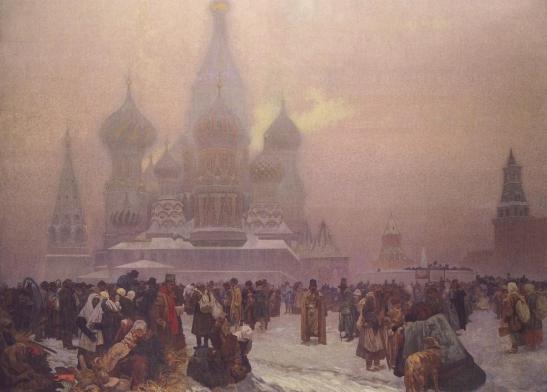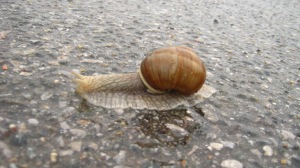Last weekend, I braved the rain and the onset of a cold (or Lyme’s disease…who can say…) to view, with me own eyes, the epicness that is The Slav Epic.
What’s this? You are not familiar with this series of 20 massive canvases depicting turning points in Slavic history painted over the course of 16 years by world-famous Czech artist, Alfons Mucha?
No worries. Neither was I a mere two years ago.
I read about them in my guidebook last year and wanted to see them, but never got to it, and it’d been on my list all of this year, so finally, at the eleventh hour, I headed into the yonder in hot pursuit of said elusive artwork.
Fifteen of the paintings are displayed in a crumbling castle in the obscure town of Moravsky Krumlov in southeastern Czech Republic. (For me, this little detail just increased their appeal.) The other five are somewhere in Prague.
I couldn’t find anyone to take the 3+ hour trip with me (surprise, surprise) so I boarded the bus to Brno by myself in the early hours of Saturday. After I took my seat, I launched into a fit of coughing–a throaty, phlegmy cough–guaranteed to cause potential seatmates to look for another. I don’t like sharing bus seats. Unfortunately, the bus was quite full, and the seat next to me was taken by a middle-aged, scruffy-looking nerf-herder who proceeded to speak to me in Czech. At first, I smiled politely and said, “Omlouvám se, mluvím trochu česky.” (I’m sorry, I speak little Czech.) This did not dissuade him from converstation, nor did it cause him to slow down or speak more clearly (he was a bit of a mumbler). So I followed up with, “Nerozumím česky.” (I don’t understand Czech.) Still no change. “Moje česky je moc špatné.” (My Czech is very bad.)
All of these statements were said with such poor grammar and in such a putrid accent as to leave him in no doubt of their truthfulness. However, throughout the 2.5 hour ride he continued muttering in my ear and looking at pictures of naked women in his newspaper. I’m rather glad I didn’t know what he was saying. Finally, I just feigned sleep, offering up a juicy cough now and again, hoping to create the impression of contagious upper respiratory infection.
It was raining steadily in Brno, where I was to catch another bus to Moravsky Krumlov, an hour away. The departure bus stop was about half a kiliometer from our drop-off point. But I could see the train station from where I was, so I decided to take a train on account of my knowing where the trains were and having only a slightly damp Google maps print-out to help me find the bus stop.
The train slogged through the wet and fog, and I opened the window to stick my head out, savoring the joy of an unexpected train ride. Finally, the train screeched to a stop at a bright yellow station boasting “Moravsky Krumlov” in foot-high white letters. I disembarked and headed into the surprisingly modern-looking station to get the afternoon train schedule. The kind lady printed off the return times, which I pocketed, and I marched confidently out into the rain.
To the rear of the station were rolling hills topped by farmland. In front was an industrial park, the gravel road leading to it covered with relaxing snails. There was no town, no crumbling castle, no Slav Epic in sight. I wandered back to the station and poked my head in. A couple were at the window, apparently not pleased with the train times they were being given. I tapped the lady and asked, “Kde je centrum?” (Where is the city center?) Between her and her husband, they led me to understand that the city center was five kilometers away (they motioned generally down the road) and that a bus would be at the station in about 10 minutes which could take me to the center. I found out later that these buses only come every few hours, so it was lucky I was there!
The lady chit-chatted with me for a bit and I learned that she was a preschool teacher and I told her that I also taught small children in Prague and that I was from the United States and I was here to see the painting by Alfons Mucha. This was probably the most extensive converstation I have ever had in Czech, outside of class. I was rather proud.
I was the sole passenger on the bus that dropped me in the center of the town square. Moravsky Krumlov was a mess of puddly road construction. There weren’t any people about and the one restaurant I found that looked open was actually reserved for a wedding later that afternoon.
So I ate my other Corny bar and the bag of chips I had been saving, and headed to the castle.
 It was a sad bit of castle; the walls were chipped and peeling, the grass and trees were overgrown and a disused fountain languished in the courtyard. But indeed, the 15 canvases were inside in all their impressive largeness.
It was a sad bit of castle; the walls were chipped and peeling, the grass and trees were overgrown and a disused fountain languished in the courtyard. But indeed, the 15 canvases were inside in all their impressive largeness.
I’m afraid I don’t have much of an artistic vocabulary, so I can’t  give an accurate description of said paintings, but I may offer that they were very big and I liked them quite a lot. (Some more than others.) This is one of my favorites. It’s St. Petersburg at the moment the announcement was made that ended serfdom. Mucha was going to make it a joyous scene of celebration, but he visited Russia in the 20s and was much depressed by the country’s bleakness.
give an accurate description of said paintings, but I may offer that they were very big and I liked them quite a lot. (Some more than others.) This is one of my favorites. It’s St. Petersburg at the moment the announcement was made that ended serfdom. Mucha was going to make it a joyous scene of celebration, but he visited Russia in the 20s and was much depressed by the country’s bleakness.

I also liked this one. (These aren’t my photos. There was a hefty fine for photography.) The man on the chair by the sea is the dying Jan Amos Komensky. Considered the father of modern education, he fled what is now Czech to escape religous persecution. He died in Amsterdam, never returning to his beloved homeland. 
The canvases, as I said before are pretty big. This one is a little hard to see, but you can tell the lady to the left of the painting is size tiny.

Yup. After admiring the art for much longer than was absolutely necessary (it was warm and not raining and the seats were comfortable and I was reading a good book), I pulled up my hood and wandered back into the rain, found a restaurant that was open and ate a lovely fried cheese. Then I meandered to the bus station with plenty of time to catch the bus to Brno. (I decided against venturing out to the countryside train station again.)
When I got the bus station (more of a shelter actually) it seemed strangely deserted. I couldn’t find the sign for Brno. I tapped on the window of a bus parked off to the side, which contained a snoozing driver. “Kde je autobus do Brno?” I inquired. He shook his head and said something about the vlak (train). After lots of gesturing on my part, and very patient repeating on his part, I came to understand that buses did not go to Brno, only trains.
By the time we got that established, it was too late to get to the train station. So I had to wait two hours until the next train. This caused me to miss the bus in Brno, so I bought a train ticket (considerably more expensive) and then the train was delayed almost an hour.
So my trip was extended a bit, but I met some very kind and helpful people and had more than a few chances to butcher the lovely Czech language. All told, it was a very nice outing.
It was perhaps my last jaunt outside Praha until the final departure. ‘Twill be a bittersweet good-bye for sure. I don’t like saying good-bye, so I haven’t really let it sink in that I’ve only got 1.5 more weeks here. But it’s true. In only 11 days, a most interesting chapter in my life will be snapped firmly shut. And I will be off to the vague reality of whatever lies ahead.

Eric
June 4, 2011 at 7:05 pm
Is it odd that I knew who Alfons Mucha was?
rpdblotter
June 4, 2011 at 11:26 pm
Maybe.